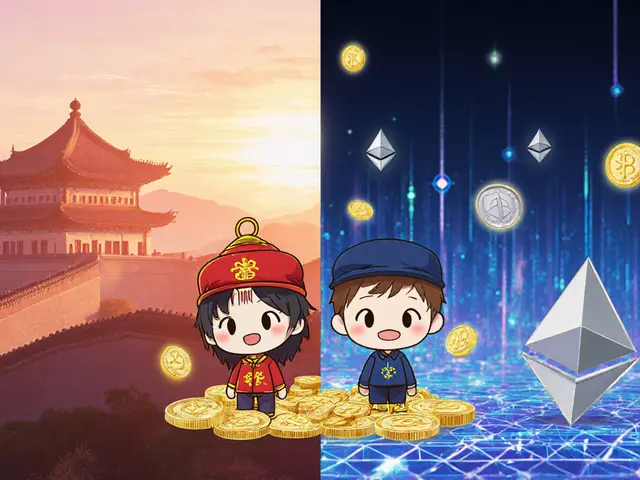Tharwa (TRWA) Token Calculator
thUSD Stablecoin
1:1 USD backed by real-world assets
TRWA Token
Revenue-share token with yield potential
Asset Allocation Calculator
Expected Returns & Allocation
Asset Distribution
Projected Annual Yield
Estimated Monthly Earnings
Potential TRWA Value Increase
Quick Overview
- Tharwa (TRWA) is a dual‑token DeFi protocol that backs its stablecoin, thUSD, with real‑world assets and an AI‑driven hedge‑fund engine.
- Launched in July2025 under UAE regulation and Sharia‑compliant certification.
- TRWA supplies revenue‑share rights; thUSD maintains a 1:1 peg to the U.S. dollar.
- Tokenomics: 10billion total TRWA, ~7billion circulating, price ~ $0.0097 (Oct2025).
- Key differentiators: diversified asset vaults, AI‑based portfolio rebalancing, and regulatory compliance.
When you see the name Tharwa (TRWA) is a decentralized finance protocol that tokenizes a blend of real‑world assets-real estate, gold, private credit, and treasury bills-into a stablecoin ecosystem. The project debuted on July12025 and operates from the United Arab Emirates under a Sharia‑compliant regulatory framework. it’s easy to assume it works like any other stablecoin. In reality, Tharwa runs a two‑token model that mixes a traditional dollar‑pegged stablecoin (thUSD) with a revenue‑sharing token (TRWA). The backbone is an AI‑driven hedge‑fund engine that constantly optimizes the asset mix to keep risk low and yields competitive.
The Dual‑Token Model: thUSD and TRWA
The protocol’s architecture hinges on two complementary tokens:
- thUSD is the stablecoin component. Each thUSD is backed 1:1 by a basket of real‑world assets stored in on‑chain vaults. The assets include commercial real‑estate, physical gold, private credit instruments, and government treasury bills.
- TRWA is the value‑accrual token. Holders earn a share of the protocol’s fees, yield from the underlying assets, and governance rights for protocol upgrades.
Because the two tokens serve distinct purposes, users can choose to hold thUSD for a low‑volatility store of value or TRWA for higher‑risk, higher‑reward exposure.
Real‑World Asset Collateral and Diversification
Tharwa’s biggest claim to fame is its diversified RWA backing. Most RWA projects today lock a single asset class-often real estate or invoices-into a vault. Tharwa blends four asset classes into each vault, creating a portfolio that mirrors a balanced mutual fund. The composition looks roughly like this:
- 35% commercial real‑estate (office and retail properties across the GCC).
- 25% precious metals (primarily gold stored in audited vaults).
- 25% private credit (senior loans to vetted SMEs).
- 15% sovereign treasury bills (UAE and US Treasury securities).
By spreading risk across sectors, Tharwa reduces the chance that a single market shock will break the dollar peg. The diversified approach also offers a higher average yield-around 5‑7% annualized as of October2025-compared with the 2‑3% typical of single‑asset RWA stablecoins.
AI‑Driven Portfolio Management
The protocol’s AI engine is where the real magic happens. Built on a Conditional Value at Risk (CVaR) optimization model, the engine constantly scans market data, credit ratings, and macro‑economic indicators. When the model detects an imbalance-say, a sudden dip in gold prices-it automatically rebalances the vaults, buying more of the undervalued assets and trimming exposure to over‑exposed ones.
Key technical points:
- Fully on‑chain execution reduces reliance on off‑chain operators.
- Rebalancing frequency can be as low as every 4hours, depending on market volatility.
- The AI model incorporates a CVaR threshold of 2% to ensure that tail‑risk remains within acceptable limits.
This dynamic approach sets Tharwa apart from static RWA stablecoins, which only adjust collateral manually and often lag behind market movements.
Token Economics and Technical Specs
Here’s a snapshot of the numbers that matter:
- Total supply: 10billion TRWA.
- Circulating supply (Oct2025): 7billion TRWA.
- Current price: $0.009738 per TRWA.
- Market cap (circulating): $59.4million; fully diluted: $84.9million.
- 24‑hour trading volume: $2.7million (≈20% price rise on the day).
The token runs on the Ethereum blockchain, using ERC‑20 standards for both thUSD and TRWA. Smart contracts have undergone two external security audits (by Quantstamp and CertiK) and include a multi‑signature treasury governance model to protect against rogue withdrawals.

Market Performance and Liquidity
Since its July2025 launch, TRWA has experienced classic early‑stage volatility. The all‑time high hit $0.0208 on August152025, while the low dropped to $0.002174 on July162025. Recent price action has settled between $0.008 and $0.010 as the market digests the AI‑rebalancing results.
Liquidity is moderate. Daily volume hovers around $2‑3million, enough for retail trades but potentially limiting for large institutional orders. Exchanges listing TRWA include Binance, KuCoin, and a few regional Middle‑East platforms that cater to Sharia‑compliant assets.
Regulatory and Sharia Compliance
Tharwa is registered with the UAE’s Securities and Commodities Authority (SCA) and holds a Sharia‑compliance certificate from the International Islamic Finance Council. This dual compliance opens doors to Islamic finance investors who have historically avoided conventional DeFi projects. The protocol enforces KYC/AML checks for users entering the RWA vaults, ensuring that only verified participants can mint or redeem thUSD.
CEO Saeed Al Fahim leads the project and emphasizes the importance of aligning blockchain innovation with regional regulatory standards. The team’s legal advisory board includes firms from Dubai and Abu Dhabi that specialize in fintech regulation.
Getting Started: How to Use Tharwa
For a newcomer, the onboarding flow looks like this:
- Download a compatible wallet (MetaMask, Trust Wallet, or the native Tharwa app).
- Complete KYC if you plan to mint thUSD or invest in vaults.
- Transfer ETH or USDC to the wallet to cover transaction fees.
- Visit the Tharwa dashboard, choose either “Mint thUSD” or “Stake TRWA”.
- Confirm the transaction; the AI engine immediately allocates your funds across the diversified vault.
- Monitor earnings through the dashboard’s real‑time asset allocation chart.
Staking TRWA rewards are distributed weekly, and earnings can be reinvested automatically via the “auto‑compound” toggle.
Comparison Table: Tharwa vs. Major Stablecoins
| Feature | Tharwa (thUSD/TRWA) | USDC | USDT | Centrifuge (cUSD) |
|---|---|---|---|---|
| Backing | Real‑world assets (real estate, gold, credit, treasury bills) | Fiat reserves (US dollars) | Fiat reserves + crypto collateral | Single‑asset RWA (invoice financing) |
| Regulatory status | UAE‑approved, Sharia‑compliant | US Federal Reserve‑approved | US regulators (varies by jurisdiction) | EU‑regulated |
| Yield potential | 5‑7% annual (from diversified vaults) | 0% (pass‑through) | 0% (pass‑through) | 3‑4% (invoice financing) |
| Liquidity (24h volume) | $2‑3M | $30B+ | $70B+ | $200M |
| AI‑driven rebalancing | Yes (CVaR‑based) | No | No | No |
Pros and Cons
Pros
- Diversified RWA backing reduces single‑asset risk.
- AI engine automates risk management and yield optimization.
- Sharia compliance opens a large untapped investor base.
- Revenue‑share token (TRWA) offers an extra income stream.
Cons
- Price volatility is still high for TRWA; not a pure “stablecoin”.
- Liquidity is modest compared with USDC/USDT.
- Regulatory acceptance outside the UAE remains uncertain.
- Complexity of the dual‑token model may deter newcomers.
Frequently Asked Questions
What is the difference between thUSD and TRWA?
thUSD is a stablecoin designed to stay at a 1:1 dollar peg, backed by a basket of real‑world assets. TRWA is a separate token that gives holders a share of the protocol’s fees and governance rights. In short, thUSD is for stability; TRWA is for upside and voting power.
How does the AI rebalancing work?
The AI engine monitors market data, credit scores, and macro indicators. Using a Conditional Value at Risk (CVaR) model, it automatically buys or sells assets in the vaults to keep risk within a 2% threshold. All adjustments happen on‑chain without human intervention.
Is Tharwa compliant with Islamic finance principles?
Yes. The protocol holds a Sharia‑compliance certificate from the International Islamic Finance Council, and its asset mix avoids interest‑bearing instruments that conflict with Islamic law.
Can I earn yield by holding TRWA?
Holding TRWA earns you a portion of the fees generated by the vaults and any excess yield after covering operating costs. Rewards are paid weekly and can be auto‑compounded.
What are the risks of investing in Tharwa?
Risks include market volatility of the underlying assets, AI model failure under extreme conditions, regulatory changes outside the UAE, and limited liquidity for large trades. As with any DeFi project, smart‑contract bugs are also a possibility.




alex demaisip
September 26, 2025 AT 21:06The Tharwa protocol employs a dual‑token architecture comprising thUSD and TRWA, where the former maintains a 1:1 USD peg via a diversified basket of real‑world assets. The latter functions as a revenue‑share instrument, entitling holders to a proportional slice of protocol fees and yield streams. Its AI‑driven rebalancing engine utilizes a Conditional Value‑at‑Risk (CVaR) optimization model to maintain exposure within a 2 % tail‑risk threshold. Regulatory compliance is achieved through registration with the UAE Securities and Commodities Authority and a Sharia‑compliance certification. Consequently, the system presents a compelling case study for asset‑backed stablecoin engineering.
Elmer Detres
September 28, 2025 AT 14:46Nice summary, bro! 👏 This gives a clear picture of how the AI engine adds value.
Tony Young
September 30, 2025 AT 11:13When I first laid eyes on the Tharwa whitepaper, I felt like I was reading a sci‑fi novel about finance. The concept of blending commercial real estate, bullion, private credit, and sovereign bonds into a single on‑chain vault is audacious. The AI‑driven rebalancing mechanism, built on a CVaR framework, promises a dynamic response to market turbulence that most static RWA stablecoins simply cannot match. Moreover, the protocol’s decision to mint a separate revenue‑share token (TRWA) decouples stability from upside, allowing risk‑averse investors to cling to thUSD while speculative players chase token appreciation. The governance model, anchored by a multi‑signature treasury and audited smart contracts, adds an extra layer of security that many DeFi projects overlook. From a regulatory standpoint, the UAE registration and Sharia‑compliance certificate open doors to a massive pool of Islamic finance capital that has historically shied away from crypto. Yield projections of 5‑7 % annualized, derived from the diversified asset pool, are impressive when juxtaposed against the meager 0 % yields of fiat‑pegged stablecoins like USDC. Liquidity, while modest at $2‑3 million daily, is sufficient for retail participants and could scale as institutional confidence builds. The tokenomics, with 10 billion TRWA total supply and roughly 7 billion circulating, give a market cap that is still in the micro‑cap range, offering considerable upside potential. The on‑chain execution of rebalancing every four hours showcases a commitment to transparency and reduces reliance on off‑chain custodians. Critics may point to the volatility of the TRWA token, but that volatility is an intentional design choice to reward risk‑bearing investors. The AI’s ability to automatically buy undervalued assets and trim over‑exposed ones mirrors the actions of a seasoned hedge fund manager, but without the opacity. Security audits by Quantstamp and CertiK further reinforce confidence in the smart contract codebase. In practice, users can mint thUSD or stake TRWA via a straightforward dashboard, with KYC only required for vault interactions, striking a balance between decentralization and compliance. As adoption grows, the protocol could serve as a template for future hybrid stablecoins that aim to combine stability with real‑world yield. Overall, Tharwa stands out as a bold experiment at the intersection of DeFi, traditional finance, and regulatory innovation. 😊
Fiona Padrutt
September 30, 2025 AT 12:36Exactly the kind of home‑grown tech the West needs to stay ahead of the curve! This AI‑driven vault approach could set the standard for future American‑run stablecoins, and it proves that innovation isn’t limited to Silicon Valley.
Briana Holtsnider
September 30, 2025 AT 14:00While the enthusiasm is noted, the assumption that Western markets will automatically adopt an Emirati‑origin token is naïve. The regulatory arbitrage may backfire once larger jurisdictions tighten oversight, and the purported “home‑grown” narrative dismisses real operational risks.
Corrie Moxon
September 30, 2025 AT 15:23Fair point about regulatory scrutiny; however, the multi‑jurisdictional compliance framework could serve as a bridge rather than a barrier. Let’s keep an eye on how the audits hold up under future stress tests.
Jeff Carson
October 2, 2025 AT 13:13The Sharia‑compliance angle is especially intriguing because it unlocks a segment of investors usually excluded from crypto. By aligning with Islamic finance principles, Tharwa may capture capital that seeks ethical, asset‑backed exposure. Plus, the UAE’s proactive stance on fintech provides a supportive regulatory sandbox. 🙂
Anne Zaya
October 3, 2025 AT 17:00Honestly, the UI looks pretty slick, and the step‑by‑step guide makes minting thUSD feel almost too easy. If the back‑end lives up to the hype, this could be a sweet entry point for newcomers.
Emma Szabo
October 4, 2025 AT 20:46Wow, the blend of gold, real estate, and private credit feels like a rainbow of financial flavors! 🌈 It’s rare to see a protocol that actually tries to diversify like a traditional mutual fund while staying on‑chain. Definitely worth a deeper dive.
Fiona Lam
October 6, 2025 AT 00:33Look, if you’re not impressed by a stablecoin that actually backs its dollar with bricks and gold, you’re probably still stuck in the meme‑coin era. Get with the program.
OLAOLUWAPO SANDA
October 7, 2025 AT 04:20It looks good but I think it’s overhyped. Let’s see real results.
Alex Yepes
October 8, 2025 AT 08:06The prospect of an AI‑mediated asset allocation mechanism constitutes a noteworthy advancement in decentralized finance. One anticipates that such automation will mitigate human error and enhance yield efficiency. Accordingly, the protocol merits close observation.
Sumedha Nag
October 9, 2025 AT 11:53Everyone’s hyped about the yields, but remember that real‑world assets can get stuck too. Don’t put all your hopes into a fancy algorithm.
Holly Harrar
October 10, 2025 AT 15:40Tharwa looks promising, but dont forget the gas fees can eat up a lot of the returns.
Vijay Kumar
October 11, 2025 AT 19:26Exciting stuff! The auto‑compound toggle is a nice touch that could really boost long‑term earnings. Just make sure you keep an eye on the rebalancing frequency.
Edgardo Rodriguez
October 12, 2025 AT 23:13In contemplating the architecture of Tharwa, one is reminded of the ancient balance between stability and ambition, yet, here, the equilibrium is engineered through code; the AI, serving as a modern steward, tirelessly adjusts exposure, thereby echoing the timeless pursuit of optimal risk‑adjusted returns; this synthesis of finance and technology, undeniably, heralds a new epoch in decentralized economies.
mudassir khan
October 14, 2025 AT 03:00The purported AI rebalancing sounds like marketing fluff; without transparent performance data, claims of risk mitigation remain speculative. Moreover, the dual‑token model adds unnecessary complexity that could deter serious investors.
Bianca Giagante
October 15, 2025 AT 06:46While I respect the innovative spirit behind Tharwa, it is essential to remain vigilant about potential pitfalls; governance mechanisms must be robust, and audit reports should be scrutinized thoroughly, otherwise, enthusiasm may give way to disappointment.
Andrew Else
October 16, 2025 AT 10:33Oh great, another “AI‑powered” stablecoin that will magically solve all our problems. Sure, Jan.
Susan Brindle Kerr
October 17, 2025 AT 14:20Honestly, the whole thing feels like a theatrical performance where the lead actors promise a happy ending, but the backstage crew is still figuring out the script. Let’s hope the curtain doesn’t fall too soon.
Jared Carline
October 18, 2025 AT 18:06The analysis overlooks the geopolitical implications of a UAE‑backed token operating globally; such factors could influence cross‑border adoption and regulatory treatment.
raghavan veera
October 19, 2025 AT 21:53At the end of the day, money is just a story we tell each other, and Tharwa is trying to rewrite that story with bricks, gold, and code. Whether that narrative sticks remains to be seen.
Danielle Thompson
October 21, 2025 AT 01:40Great insight! 👍